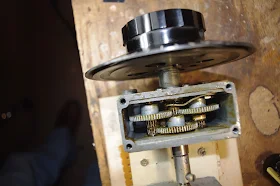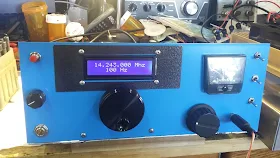SolderSmoke Podcast #189 is available:
http://soldersmoke.com/soldersmoke189.mp3
Billy in Europe. Bill in Virtual Reality.
Great News: Little Gonzalo is "all clear." Thanks for the help.
BENCH REPORTS:
Pete paints the rigs blue.
Pete's FET amplifier project with FET switching and key pad
Using an Si5351 for CW offset and QSK.
Bill working on VFO for a rig built around HRO dial and gear box.
HRO gears seem a bit loose. What should I do?
The search for an Imperial Whitworth.
For variable caps, brass is better, but two bearings beats brass.
QSO REPORTS
Pete having fun with homebrew rigs.
Bill works K3MRK, WA3O, W4OP, W1VLF and N6ORS
MAILBAG:
Dallas CBLA
Conventional Current Flow Controversy
"I regret ever listening to your podcast!"
LCR recommendations
Gonzalo just turned TWO and is doing very well




An apology, Bill: I may have given you a "bum steer" through punctuation. The capital I in "Imperial" does not make it an integral part of the description, it is the generic term for the British (Empire) system of measurement that the USA still uses :) ! Just ask a half-competent mech engineer or mechanic for a "quarter Whit by two bolt" and he'll hand you a 1/4" Whitworth bolt 2" long.
ReplyDeleteNope. Imperial and the United States customary systems of measurement are not quite the same thing. https://en.wikipedia.org/wiki/Comparison_of_the_imperial_and_US_customary_measurement_systems
DeleteBesides.. even if they were the same.. nobody else uses it anymore. If you fished a radio out of your neighbor's trash bin, cleaned it up and installed it in your shack would you keep referring to it as your neighbor's radio or as your own?
p.s. Inches, miles, acres, gallons: all Imperial! In my opinion a far more humanly useful system, though it is mathematically cumbersome. It's all going (or gone) decimal: Centimeters (metres?), kilometers, hectares, litres - Yuk!
ReplyDeleteGreat news on Gonzalo.
ReplyDeleteBill - just saw your comment on my blog and replied. Haven't listened to SolderSmoke 189 yet, so forgive me if I am imparting redundant information. After looking at the photo of your gearbox here, I think the best thing for you to do is - remove the eccentric hub from the front of the gearbox by removing the 4 screws that hold it on. The hole through which the tuning spindle goes is circular but it is off-center (eccentric) so you MUST replace this hub in the same orientation. If you look closely at the hub, you may see the word "top" written at the top of the hub. When you slowly pull the hub out, you can gently disengage the gear on the main tuning spindle from the other two gears. If the spring is attached at both ends but just loose, you can then re-tension the gears before re-engaging the main tuning spindle (don't be shy - lots of tension!) If it has come detached, hopefully all you have to do is re-attach it and, as we say in the UK, Bob's your Uncle and Fanny's your Aunt!
ReplyDeleteBest!
Dave
AA7EE
The web site discusses backlash adjustments for two different types of HRO gear boxes, NPW and PW.
ReplyDeletehttps://www.prismnet.com/~nielw/PW_NPW_Dial/hro_dial.htm
Good luck with it!
Jim
N8CAH
Yes, what Jim said. That page is useful. Also, for National HRO eye candy, have a gander at -
ReplyDeletehttp://www.radioblvd.com/National%20HRO.htm
- and eat your heart out when you see an ad from back in the day, advertising brand new National HRO's for the princely sum of $167.70! This page has useful info on how the dial comes apart and goes back together, if you do that at any point. Just do a search for the phrase "PW-D micrometer dial assembly" and it's the second result.
Also, Henry WA7YBS, who runs the site, is a walking encyclopedia of vintage radio information. He has done beautiful restorations on many National HRO's. He used to run The Western Historic Radio Museum in Virginia City, Nevada, but it is sadly now closed down. His website still lives though, and it is amazing. His e-mail address, which is on the site, is his callsign AT gmail.com
I'm sure I'm telling you things you already know, but try looking at that page I just linked, and not feeling a strong desire for one of those beautiful National HRO receivers. We had some really neat vintage receivers in the UK (where I grew up) but, to me, the National HRO is the most wonderful combination of simplicity, ruggedness, utility, and beauty. R-390A's are also gorgeous, and have better performance, but they are bigger, weigh far more, and are so mechanically complex that I'd be wary of taking one in. If a National HRO turned up on my doorstep, it would feel like an old friend coming home to roost. I'd open the door and let it right in!
You can tell that I'm single and live alone can't you? :-)
73 for now,
Dave
AA7EE
PS - a quick word about brass-vaned variable capacitors, which you were talking about. Quite a few of the good quality caps from the big manufacturers in those days were nickel-plated brass. The silvery color was just the nickel plate, but they had the low temperature co-efficient of brass. All my old Hammarlund variable capacitors are made that way,
ReplyDeleteDave
AA7EE
As always, a great podcast. Glad to here that Gonzalo is healthy.
ReplyDeleteHey Bill, can the DSB XMTR be used in CW band if you use a 700hz audio oscillator into the mic input?
ReplyDeleteTnx & 73
Km6wt
You could, but this would be kind of annoying and unnecessary -- you'd be putting out CW signals on two frequencies, 1.4 kHz apart. Better to just bypass the balanced modulator on transmit and send the oscillator energy directly to the RF amplifiers.73
DeleteI have the easy solution for your gearbox woes. It does turn some right? You just don't get enough change from a given amount of turning? Here's the fix for that. First disconnect the gearbox from the shaft of your variable capacitor. Now in it's place connect your gearbox to the shaft of your rotary encoder. Connect your Arduino and DDS chip. Now you can tweak the change all you want by adding a multiplier in code! Find the multiplier that makes it just right....
ReplyDeleteOnly kidding of course. Good luck, can't wait to hear how you fix it. Thanks for the podcast!